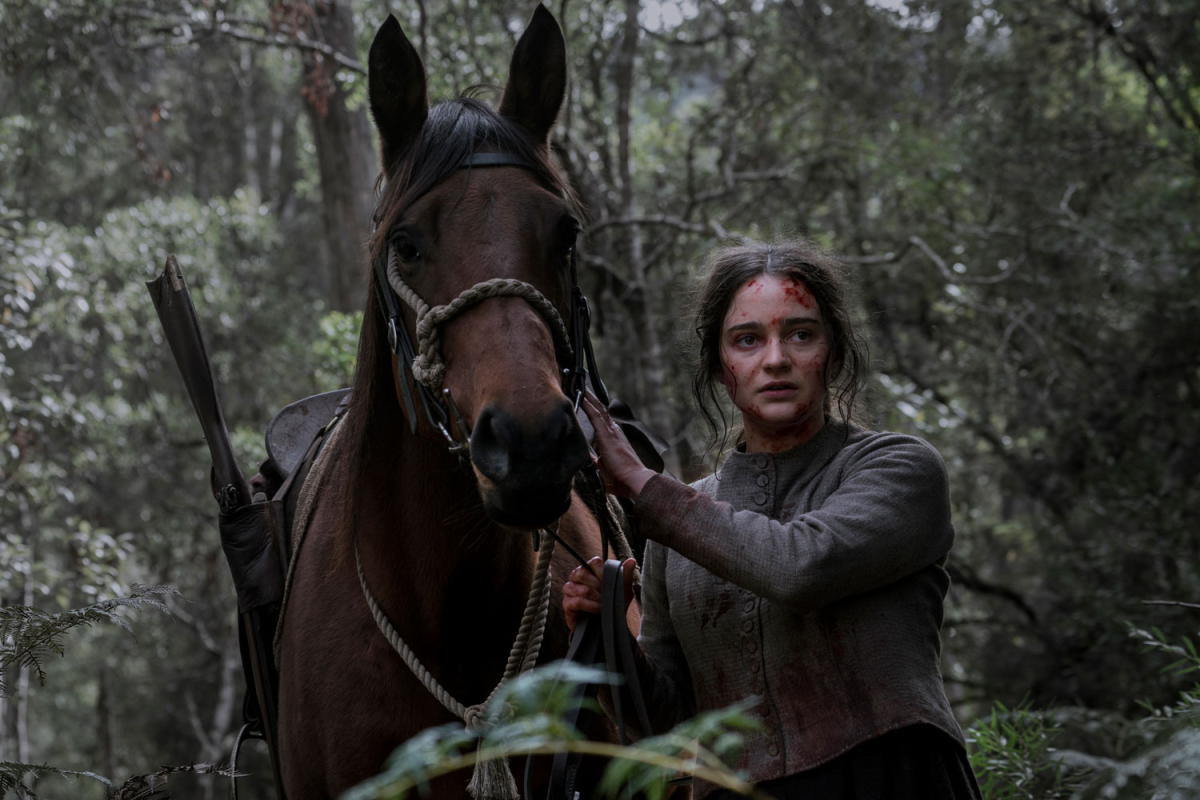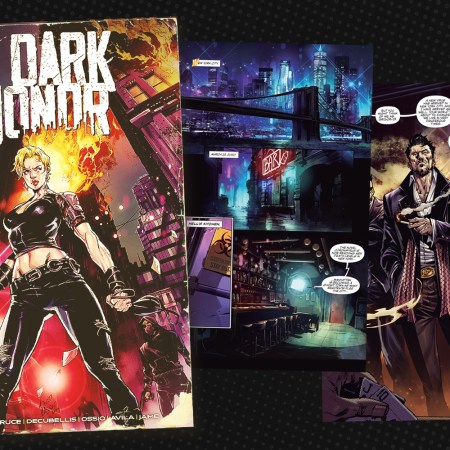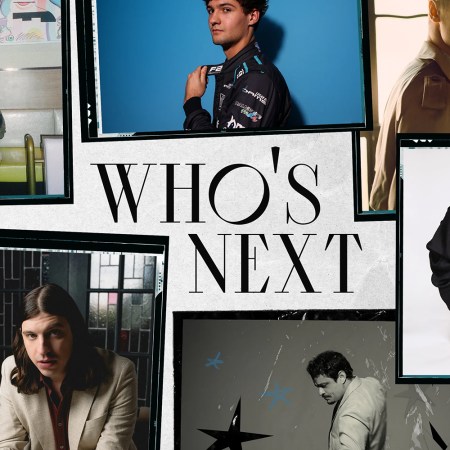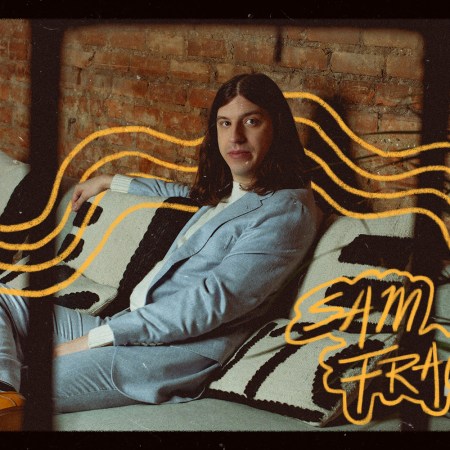Trigger warnings have been a hot-button talking point on college campuses and in the workplace for a few years now, but the MPAA’s handy rating system has heretofore allowed the cinema to go largely untouched. The new film The Nightingale, an unsparing Western by way of Australia and director Jennifer Kent’s follow-up to 2014 horror sensation The Babadook, may very well change that. Distributor IFC has sent members of the press attending advance screenings an email containing a note explicating the context and significance of the film’s liberal amounts of sexual and racially motivated violence. Aisling Franciosi, the film’s steely and mesmerizing lead, received no such warning.
“I was a bit naive, going into this,” Franciosi tells InsideHook over the phone from her home in Ireland. “I knew it would be difficult, but I also thought in some ways it could be really cathartic for me. I didn’t realize just how hard it is to turn the character off at the end of each day.”
Setting aside her brief stint on Game of Thrones, she’s made a name for herself with her steadfast turn as Clare, a woman muscling through a gauntlet of suffering. It’s 1825 in The Nightingale, and she’s been sent to the Tasmanian penal colony for the unforgivable crime of being too poor to settle her debts. The first act of the film afflicts her with unimaginable pain rendered terribly, immediately real in Kent’s sensitively shot scenes: a sadistic officer with the British army (Sam Claflin) violates her in full view of her husband and infant child, and then turns his gun on the two of them. He leaves Clare for dead as he embarks on a trip through the brush to rendezvous with his military superiors, but she survives. And she vows to have her revenge.
For Franciosi, total immersive commitment to the character was the only path to a successful performance. She didn’t fully realize, however, that she’d set out on a journey just as perilously fraught as Clare’s. “I just so badly wanted to play this part that I said to Jen, ‘I will give you everything I have to give.’ I was willing to throw myself into this,” Franciosi recalls. “In retrospect, maybe there was a way to do that and reset myself at the end of the day. But Jen took care of us; at the end of the job, she had us check in with a clinical psychologist attached to the project to be sure I was okay.”
She and Kent collaborated to establish a set of circumstances under which trauma could be playacted in a safe, controlled environment. (All the talk of limits and aftercare brings to mind the language of BDSM, another personally sanctioned expression of brutality.) Kent refrained from fully rehearsing the rape scene, instead scheduling “mechanical rehearsals” during which the actors could get comfortable with each other and their blocking while marking time in terms of their emoting. This approach kept everything fresh for the actual shoot while ensuring that there wouldn’t be any surprises or room to get carried away.
Franciosi recalls these demanding days in the tone of a veteran, heavy and knowing. “In a great and awful way, we were really shooting in a tiny cabin. It wasn’t a set where you’d pull all the walls but one away. That made it claustrophobic and hot. We had a closed set, but it was still really hard. We had big, strapping Australian crew members crying in the room. Took us two days to do that one scene. Everything about it was intense.”
At every step of the process, a foundation of trust and care saw Franciosi and Kent through on a high-wire, high-stakes shoot. Clare’s mission requires a multi-day sojourn through forbidding woods, crawling as they are with natural predators and aborigines prepped to kill the encroaching white colonists on sight. “It was a symbiotic combination — the physical strain contributed to the emotional exhaustion and vice versa,” she says. “We were filming in inhospitable conditions for most of the time, weather was cold, I got hypothermia on the last day of shooting. Muskets are incredibly heavy, I learned. With all the horseback riding on top of that, it was all very physical … I did weeks of training to make sure that I’m fit and strong, and I honestly think it would’ve been an issue if I hadn’t done all that prep. Very draining, so that by the end, I was completely spent.”
For security, she strikes an uneasy alliance with Billy (Baykali Ganambarr), a native tracker and — for the right price — guide to Clare. If the scenes of violation presented a physical and emotional challenge to those working on them, the current of racism from Clare to Billy posed a more complicated test of creative ethics. Kent and Franciosi jointly threaded a tricky needle; the director had to preserve the ugly politics of this era for the sake of honesty, while her star avoided the pitfalls of alienating out-and-out bigotry or anachronistic wokeness.
“As for the racially motivated violence in the film, that’s a part of history,” Franciosi firmly says. “In Australian schools, you’re taught that there was a total genocide in Tasmania, and that’s not quite true. It was an almost-total genocide, but there’s an aboriginal population still there. It’s just that because they’re not what would be called ‘full-blooded’ aboriginals, people try to deny this heritage. For that population, it’s really important that this story of near-complete annihilation be told for exactly what it is, and to not let people give a different version of events. People focus on the violence against Clare, but this other half of the story is just as powerful, especially with the palawa kani language up on the screen. They can reclaim a bit of that heritage. They’re still here.”
Putting in the work of empathy meant the difference between a film intelligently and sensitively engaging with touchy material, and a provocation going rogue into problematic territory. Franciosi’s spoken with survivors of sexual assault at festival screenings of the film, some of whom can’t bear to sit for the entire film and some of whom feel moved at seeing their struggle onscreen. “I talked to survivors,” Franciosi says, “I talked to social workers, and I felt that I owed it to the people who’d shared their experiences and to victims in general to do this as truthfully as I could. I still get chills thinking about it. I had a physiological reaction to all this. At the Sundance screening, my legs started to shake and I got goosebumps.”
Like a bruise, Clare stayed with Franciosi. The nightly parties for morale had staved off her melancholia during shooting, but as soon as the whirlwind released her, she felt the full effect. Though she’d planned to head to L.A. for new work directly from Tasmania, she instead went home to Ireland and spent two months being tended to by her parents. She told her agents she didn’t want to read anything for a while. “It sounds a little dramatic, and if the version of me from before the film heard me saying this now, she’d think I was a bit pretentious,” Franciosi laughs. “But really, it was an eye-opener. I’m going to be better-equipped to protect myself from now on, I think. Going in to this one, I didn’t even have a strategy for how to get out of those headspaces. I can see how important that is now.”
Though it put her through the wringer, Franciosi prizes the time she spent with Clare. She means it when she says she’s “totally fine now,” having gained new perspective on the extremes of acting. She more sharply feels the weight that art can have, both to those inside of it and those observing. Now approximately three years out from the shoot, she looks back on her growth over the course of this production and returns to the trigger warning.
“There will be people who may be triggered by this, and letting them know what they’re getting themselves into, that’s perfectly fine,” Franciosi says. “What I appreciate is people not misrepresenting what kind of violence this is. People hear something’s got violence and they get scared — for example, my mom can’t watch anything violent — but she was able to watch this. It was difficult for her, awful and devastating, but she said it felt different because it wasn’t gratuitous or glamorizing in any way. It has a different effect.”
She’s learned the utility of pain, personally and artistically, as a path to understanding and compassion. In living through a facsimile of suffering, she’s opened up a channel for the rest of us to access these intimate tragedies in a secondhand yet no less potent form. Now, her hope is that the public will likewise recognize the virtue in the hard-to-watch. “If you can see scenes of sexual violence onscreen and not feel something, then they’ve probably been filmed incorrectly,” she concludes. “I appreciate the need to be forewarned. But I won’t for a second apologize. I’m very proud of what we did.”
This article appeared in an InsideHook newsletter. Sign up for free to get more on travel, wellness, style, drinking, and culture.
























